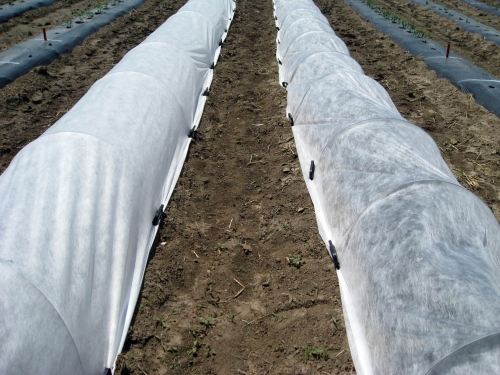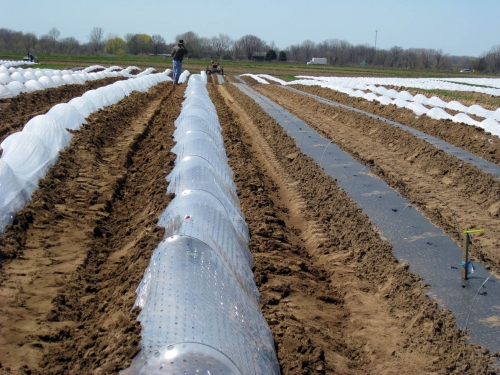Row covers for frost protection and earliness in vegetable production
Editor’s note: This article is from the archives of the MSU Crop Advisory Team Alerts. Check the label of any pesticide referenced to ensure your use is included.
Row covers are used for many reasons including, season extension (frost protection), insect exclusion, heavy rain, and hail protection. When the main objective of row covers is to increase temperature, it is important to understand several factors including: row cover type, material used, level of temperature increase, and frost protection ability.
Types of row covers
Most row covers are either floating row covers or supported by hoops. Floating row covers are supported by the plant canopy. Therefore, for use on crops with a sensitive growing point (e.g. tomato) or a frail structure, they must be made of a light-weight material. Floating row covers can be installed over multiple crop rows. Hoop-supported row covers, also known as low tunnels, are installed on individual crop rows or beds. The height can vary from 12 to 36 inches from the bed surface. They are more expensive to install than floating row covers, but the installation can be mechanized.
Materials used for row covers
Most row covers are made with polyethylene plastic or spunbonded fabrics (polyester or polypropylene). Polyethylene covers are used for low tunnels. They are lightweight and come in either solid or perforated sheets. Holes on perforated covers are important for gas and water exchange with the outside environment. Spunbonded fabrics allow for ventilation and water to pass between the fibers. Polyethylene materials are available in various thicknesses while the spunbonded fabrics are available in various weights.
Temperature increase and frost protection
When using row covers always keep in mind that they are more efficient at increasing temperature especially during a sunny day than at protecting against frost. Even in the absence of a frost risk, some growers may consider using row covers because most warm season vegetables stop growing at temperatures below 40-50oF. A row cover may increase the temperature enough to promote the growth of these warm season vegetables. In general:
- Polyethylene plastic materials build more heat than woven fabric (spunbonded).
- Clear plastics increase temperatures more efficiently than white or colored plastics
Increase in temperature under the cover during daytime may vary greatly depending on the material used. However, when it comes to frost protection, the material used is critical. Most woven fabrics and polyethylene materials used in agriculture can only protect the crop down to 28*F, but some heavy materials have shown acceptable protection down to 20*F.
Some growers have combined row covers with bed covered with plastic mulch; others have added cover crop wind breaks. Finally, some growers have attempted to improve the level of frost protection by installing double or multiple layers of the row covers.
When the outside temperature is high enough, it is recommended to remove row covers. Temperature can get extremely high inside the covers and injure the crop, especially when non polyethylene row covers without holes are used. It is also important to remove the covers at flowering stage for pollination.
In a recent visit with a grower who was installing low tunnels on beds covered with plastic mulch, we measured a temperature increase from 86oF open air to 96oF (single layer) and 113oF (double layer) tunnels. More interestingly the change in temperature occurred within five to 10 minutes following tunnels installation.

Spunbonded row cover material used in cucumber production.

Perforated plastic row covers.
Dr. Ngouajio's work is funded in part by MSU's AgBioResearch.



 Print
Print Email
Email

